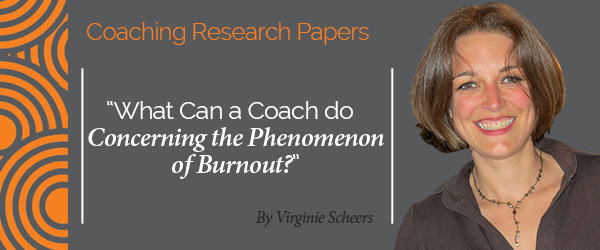
Research Paper By Virginie Scheers
(Executive Coach, BELGIUM)
What is actually a Burnout? Is it a big stress? Is it a depression? Who may be affected? Are there certain profile? Does it happen in certain types of companies?
More and more we hear about it in the media, in conversation with friends, with colleagues. Many of us know someone who faces or has faced a Burnout.
As coach, it is essential that we know and are able to recognize the process of burnout because in our job, we may have clients that are facing some degree of burnout. The goals of this Research Paper are first to inform you about what IS a burnout (Part 1) and then to show HOW we as coach can help prevent or support the people facing a burnout (Part 2).
1. About the Burnout
The first part of this research will be divided into 3 sub-parts. First, I will present you a definition of what is a burnout. Then I’ll explain its causal factors. Finally I’ll describe the characteristics / symptoms of a burnout.
1.1 Definition
[Burnout] is an English term meaning “to burn until all fuel substance disappears, being entirely consumed.
Th eperson suffering from burn out will be completely devastated internally, but the severity of his conditionwillvery oftennot be visible from the outside.
The burnout is a professional exhaustion.Some personal circumstances can worsen the situation,but these are not the main source.
The burn out is an imbalance between the effort given at workand the regeneration, the recovery of energy.
The burnout exists in all occupations and at all hierarchical levels.
Nobody is immune. (C. Vasey, 2012)
According to the World Health Organization (WHO) a burnout is characterized by a feeling of intense tiredness, loss of control and inability to achieve concrete results at work.
The burnout phenomenon has been described for the first time in 1974 by Dr. Herbert
Freundeberger, American psychologist and psychotherapist, in a scientific publication named “staff burnout.” He chose the term “burnout” in comparison with the burning of a candle. Indeed, after strongly illuminating for hours, a candle is consumed and only offers a fragile flame. Here is how he defines it:
A problem that arises from good intentions to achieve high goals (even unrealistic sometimes), generating self-detachment and the loss of contact with others.
Since then, many researchers have provided definitions of this phenomenon. Here is one that was given by Schaufeli & Enzmann and that seems to me clear and complete.
The burnout is a state of mind that is negative, persistent and work-related affecting “normal” individuals. It’s characterized by exhaustion, feelings of ineffectiveness, demotivation and dysfunctional behavior at work. This state of mind is often not noticed by the worker for a long time. It results from a difference between the intentions and the reality of work. Often workers maintain this state of mind by coping strategies that are ineffective. (Schaufeli & Enzmann, 1998, p.36 cités dans Schaufeli & Buunk, 2003)
There is often an amalgam made between “burnout”, “stress” and “depression”. Here are some clarifications:
Let’s start with the relationship between “stress” and “burnout”. In many writings we can read that the big difference between the two is related to “time”. Stress is a temporary adjustment process, unlike the burnout that has a lasting aspect. This suggests that burnout is the result of exposure to repeated and chronic stresses.
As regards to the difference with a “depression”, it is mainly relating to the different spheres of life that are affected. A burnout affects the well-being linked to work exclusively. Where a “depression” is not specific to a particular sphere of life, it is a generalized disorder mood.
It should be noted that a history of depression may facilitate a burnout and, conversely, a burnout may worsen into a depression.
1.2 The factors
It is recognized that the phenomenon of burnout has steadily increased over the past fifteen years. We can categorize there types of factors influencing it: the sociological factors, the companies’ organizational factors and the personality factors of those affected.
a) the sociological factors
Here are a number of sociological factors, described by Catherine Vasey, which may encourage the burnout:
With Internet and connections from anywhere, the work hours extend. Some talk about flexibility, but beware of over-flexibility. We can continue to work from home, send and receive e-mails at any time. This may drive a loss of harmony between private life and professional life.
Moreover, the number of emails received per day can sometimes be gigantic. There is a tendency to put everyone in copy of e-mails and given that an e-mail has been sent, it is assumed that you have everything in memory and that you are aware of everything.
The work overload is also an information overload.
As described above, on top of these sociological factors, two other type of factors are instigating a burnout: the individual factors that is to say,those related to the personality and experience of the individual and the organizational factors of the companies.
b) the individual factors
We can classify four types off actors related to the personality of the individual.Indeed,the most frequently affected are: